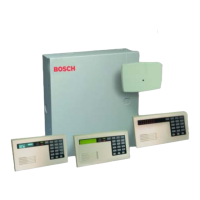D6412/D4412 Operation and Installation Guide
D6412/D4412
Page 71© 2003 Bosch Security Systems 45349E
Glossary
24-Hour Points Points that are always on even when the system is turned off. Two types: Fire Points and Non-
Fire 24-Hour Points.
Area An installer-specified collection of points that can be armed and disarmed independently. An
area can report with its own account number. Opening, closing, alarm, trouble, and restoral
reports are all associated with an area. You can organize the panel’s points and users into a
maximum of four areas (two areas max on the D4412), in essence creating four independent
systems within one control panel.
All On All controlled points are armed. All On with No Delay (Instant) is an option. No Exit or Entry
Delay is provided with the No Delay option.
Authority Level A programmable feature that determines what a user can do in a given area.
Burglary Alarm Tone A constant warble tone.
Central Station A facility where trained personnel monitor a security system 24 hrs. a day. The security system
may be programmed to contact the central station during alarm conditions, enabling central
station personnel to dispatch the proper authorities.
Control Panel A control panel combines the functionality of an alarm control panel and a digital dialer into a
single unit.
Controlled Point A point that responds to alarm conditions depending upon whether the system is turned on or
off.
Cross Point A group of points that are configured to initiate an alarm when two points have been faulted
within a programmed time. Fire points cannot be set for Cross Point configuration.
Duress Passcode A passcode that arms and disarms the system just like a personal passcode, however it sends
an alarm signal to the central station without sounding an alarm on the premises.
Entry Delay A programmed delay of the system alarm responses that allows a person to enter the building
through the entry door to turn the system off. An alarm response begins if the area is not
disarmed before Entry Delay expires.
Error Tone The same warble tone as the Trouble tone, but not repeated.
Exit Delay A programmed delay of the system alarm responses that allows a person to exit the area
before the system turns on. An alarm response begins if a point is faulted after Exit Delay
expires.
Faulted Point A point that is not normal (for example, an open door or window).
Fire Alarm Tone A warble tone that is on for 1 sec., then briefly off (repeatedly).
Follower Point A point programmed to initiate an instant alarm unless a Delay point is faulted first. When a
Delay point is faulted first, the Follower point assumes the Entry Delay time of the Delay point.
Force Arming A method of overriding the safety feature that prevents arming with a faulted circuit on a
control panel.
Global Something that affects the entire system (for example, global point configuration refers to the
programmable features that affect all points).
Independent Zone Control A device that allows a single point or zone on a control panel to be armed or disarmed
independently from the rest of the system.
Instant Alarm A point type that initiates an alarm immediately when faulted. This point type does not follow
any Entry/Exit Delay time.
Invisible Point A point that does not display at any command center during alarm or trouble conditions.
Keyfob A small, hand-held wireless device usually designed to fit on a key chain that consists of
buttons that allow the user to perform various functions, depending on the keyfob, such as
arming/disarming the system, operating outputs or sending reports.

